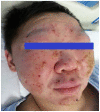Clinicopathological analysis of the hydroa vacciniforme-like lymphoproliferative disorder with natural killer cell phenotype compared with cutaneous natural killer T-cell lymphoma
- PMID: 30542432
- PMCID: PMC6257548
- DOI: 10.3892/etm.2018.6768
Clinicopathological analysis of the hydroa vacciniforme-like lymphoproliferative disorder with natural killer cell phenotype compared with cutaneous natural killer T-cell lymphoma
Abstract
Hydroa vacciniforme-like lymphoproliferative disorder (HVLPD) is defined as a distinctive clinicopathological type of cutaneous lymphoma and a subset of patients with this disease exhibit the natural killer (NK)-cell phenotype. The HVLPD-NK cell phenotype may be difficult to distinguish from cutaneous natural killer T-cell lymphoma (CNKTL), as these two diseases share similar immunophenotypic markers. Therefore, the aim of the present study was to analyze the clinicopathological features of this rare disease and compare these features with those of CNKTL. The clinical, histopathological and molecular features of 5 patients with the HVLPD-NK cell phenotype and 11 patients with CNKTL were evaluated. As well as certain subtle histopathological differences, there marked differences the age, distribution of lesions and clinical course differed between patients with these two diseases. These results suggest that the HVLPD-NK cell phenotype should be classified as a separate disorder and treated accordingly.
Keywords: Epstein-Barr virus; cluster of differentiation 56; cutaneous T cell lymphoma; differential diagnosis; hydroa vacciniforme-like lymphoproliferative disorder; natural killer T-cell lymphoma.
Figures



Similar articles
-
Hydroa vacciniforme lymphoproliferative disorder: a retrospective study of 42 paediatric cases.Eur J Dermatol. 2024 Apr 1;34(2):144-149. doi: 10.1684/ejd.2024.4648. Eur J Dermatol. 2024. PMID: 38907544
-
Hydroa Vacciniforme and Hydroa Vacciniforme-Like Lymphoproliferative Disorder: A Spectrum of Disease Phenotypes Associated with Ultraviolet Irradiation and Chronic Epstein-Barr Virus Infection.Int J Mol Sci. 2020 Dec 7;21(23):9314. doi: 10.3390/ijms21239314. Int J Mol Sci. 2020. PMID: 33297336 Free PMC article. Review.
-
Hydroa vacciniforme-like lymphoproliferative disorder in Korea.Sci Rep. 2020 Nov 9;10(1):19294. doi: 10.1038/s41598-020-76345-2. Sci Rep. 2020. PMID: 33168864 Free PMC article.
-
Oral manifestations of Hydroa vacciniforme-like lymphoproliferative disorder: a clinicopathological study of a Peruvian population.J Oral Pathol Med. 2021 Jul;50(6):530-539. doi: 10.1111/jop.13203. Epub 2021 Jun 29. J Oral Pathol Med. 2021. PMID: 34097774
-
Epstein-Barr Virus-Positive T/NK-Cell Lymphoproliferative Diseases in Chinese Mainland.Front Pediatr. 2018 Oct 9;6:289. doi: 10.3389/fped.2018.00289. eCollection 2018. Front Pediatr. 2018. PMID: 30356785 Free PMC article. Review.
References
-
- Swerdlow SH, Campo E, Harris NL, Jaffe ES, Pileri SA, Thiele Jurgen HS, Vardiman JW, editors. World Health Organization Classification of Tumors of Hematopoietic and Lymphoid Tissues. 4th. IARC Press; Lyon: 2008.
-
- Feng S, Jin P, Zeng X. Hydroa vacciniforme-like primary cutaneous CD8-positive T-cell lymphoma. Eur J Dermatol. 2008;18:364–365. - PubMed
-
- Magaña M, Sangüeza P, Gil-Beristain J, Sánchez-Sosa S, Salgado A, Ramón G, Sangüeza OP. Angiocentric cutaneous T-cell lymphoma of childhood (hydroa-like lymphoma): A distinctive type of cutaneous T-cell lymphoma. J Am Acad Dermatol. 1998;38:574–579. doi: 10.1016/S0190-9622(98)70120-3. - DOI - PubMed
-
- Barrionuevo C, Anderson VM, Zevallos-Giampietri E, Zaharia M, Misad O, Bravo F, Cáceres H, Taxa L, Martínez MT, Wachtel A, Piris MA. Hydroa-like cutaneous T-cell lymphoma: A clinicopathologic and molecular genetic study of 16 pediatric cases from Peru. Appl Immunohistochem Mol Morphol. 2002;10:7–14. doi: 10.1097/00129039-200203000-00002. - DOI - PubMed
LinkOut - more resources
Full Text Sources
Research Materials
